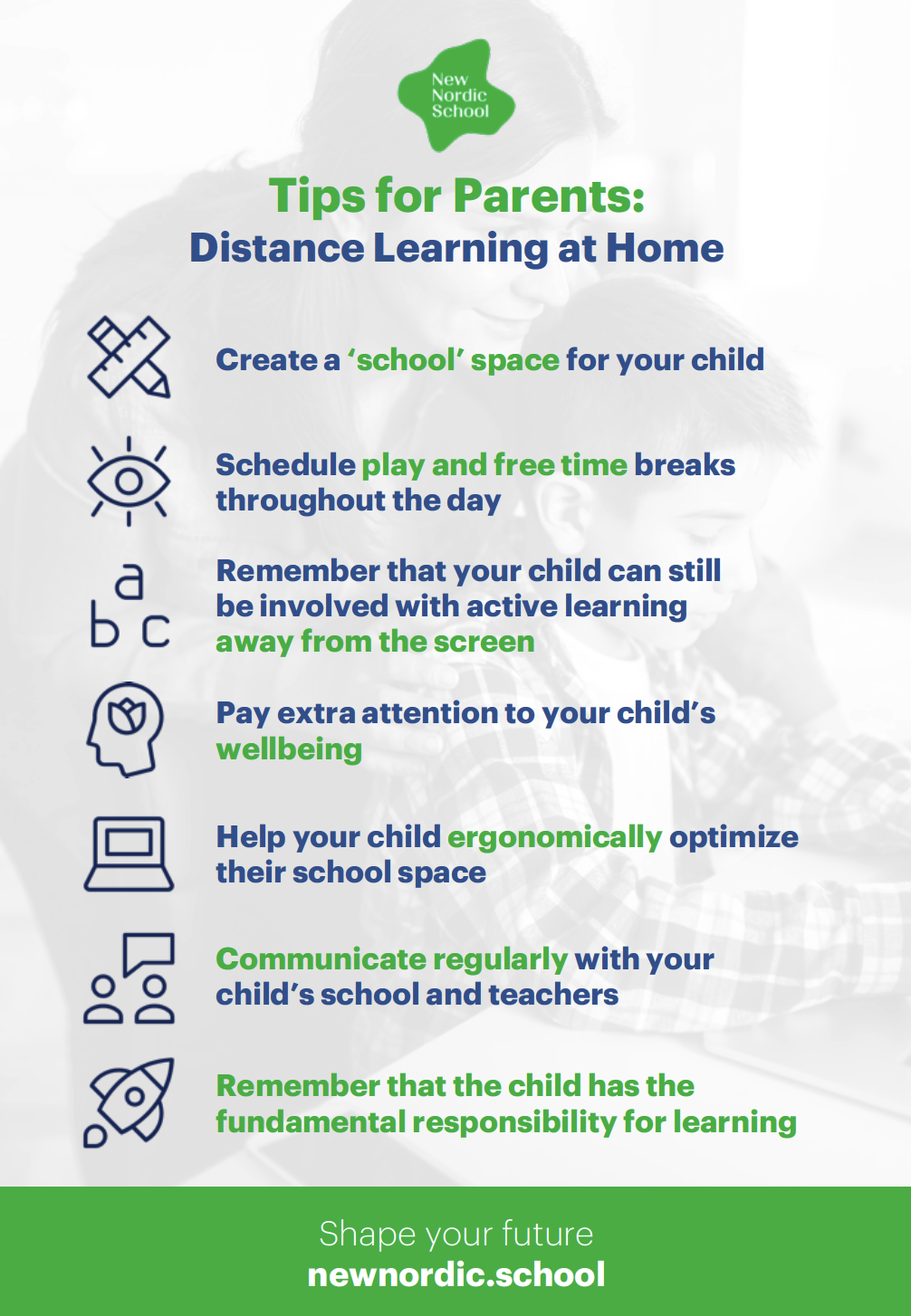Tips for Parents: Distance Learning at Home

The New Nordic School team gathered some distance learning tips to help parents around the world empower their children for their online school day.
Create a ‘school’ space for your child
The ‘school’ space at home should ideally be a peaceful place for your child to learn. In many homes around the world, the dining table has become the space for school, work, and eating. Use a table mat or cloth to indicate the space for your child, this helps them distinguish it from their regular eating space. In order to help your child engage in their learning more effectively, this space should keep distance from other siblings, kitchen noises, television, etc. This is not fully possible in all homes, but it is important to be aware of possible distraction factors. Having good internet and headphones can also help your child focus – as external distractions will be limited.
Schedule play and free time breaks throughout the day
In Finland’s education system, play and free time are essential for the holistic wellbeing of each student. Approximately 15 minutes of free time is allocated in the daily schedule for each 45 minutes of class time. This time is important to also schedule in during distance learning, to ensure that your child is not sitting by the screen in the same position all day. Create a school-like schedule for the day so that your child can follow it and see the online lessons and play time breaks. Encourage your child to have a screen-break and play outside (if possible), with toys, complete a puzzle, etc – creativity is allowed!
Remember that your child can still be involved with active learning away from the screen
Not all activities need to take place in front of the screen. Students should stay active, even when learning at home. Talk with your child’s teacher(s) about how much of the online lessons require direct screen-time and how much of the tasks can be completed off-screen. This may need more support from the parents, depending on the activity, but it will be more engaging for your child to have variety from screen-based activities. “Distance” learning just means “not at school.” It doesn’t have to be online. Kids can learn a lot by going outside. They can make art without a screen after viewing a how-to video demonstration. They can develop a physical fitness plan (with adult help and guidance) in which they try to improve some part of their performance every week and chart their growth as evidence for their portfolio. There are also about 10,000,000,000 books printed on paper that can be read while cuddled up with a peer or favorite stuffed animal.
Pay extra attention to your child’s wellbeing
Is your child feeling more anxious than usual? Overwhelmed? Reserve extra time for doing things together. It is also important to stay in contact with other parents – it is a great way to share how children are coping with being at home and how engaged they are during distance learning. You as a parent are not alone – turn to other families for support during this time and remember to schedule some virtual playdates for your child and their peers.
Help your child ergonomically optimize their school space
Just as us adults need ergonomic workspaces, our children do too. Check the position your child is sitting in: is their back supported? What angle is their head tilted at? Do their feet reach the floor? Learn more about children’s ergonomics online, for example: ergonomictrends.com. Things such as screen size and chair height have a big impact on your child’s ergonomic position, focus, and learning.
Communicate regularly with your child’s school and teachers
Ask your child’s school for a task list, online lesson schedule, and required materials list prior to the first day of the week, in order to understand and prepare in advance for what is coming. Communicating with the teacher(s) frequently is also important when trying to understand your child’s learning progress during distance learning. Other questions to ask the school:
How are students assessed during distance learning?
What kind of homework is being assigned and how frequently?
How can you, as a full-time working parent, support your child’s online activities and distance learning?
What should you do, if your home’s internet is out for a longer period? Are there some activities you could help your child with without internet
Remember that the child has the fundamental responsibility for learning
At the end of the day, remember that your child has the responsibility for their own learning, with the support of the school and home.
______________________________
Finland’s New Nordic School is transforming current systems of education. Our pre-K through grade 12 educational system empowers all students to explore their natural creativity, discover their true passions, and shape their own future. We apply the renowned Finnish curriculum integrated with best pedagogical practices from around the world to provide a personalized, purposeful, and locally relevant system. Our solution is brought to new and existing schools worldwide through our Nordic Baccalaureate curriculum, pedagogy, and Smart Learning Platform. Get in touch with us to hear more.
Interested in learning about Finland’s education system? Join our online course: Finland’s Secret to Success!